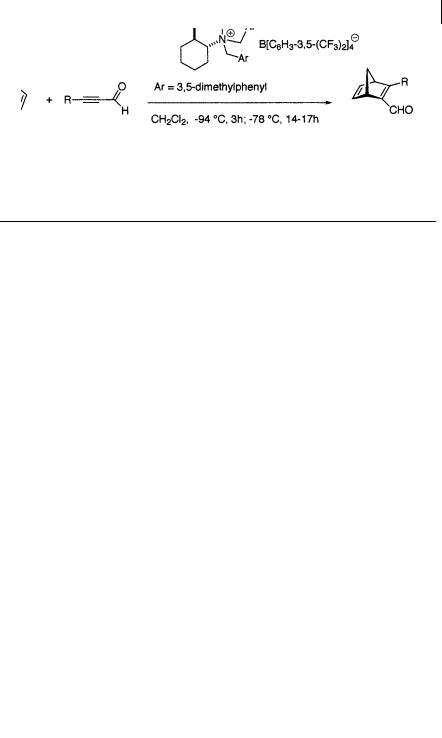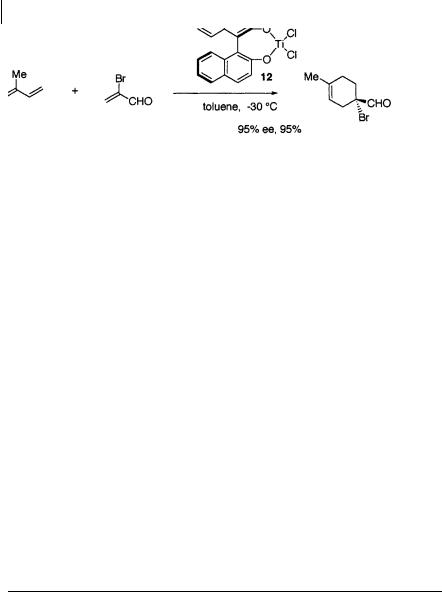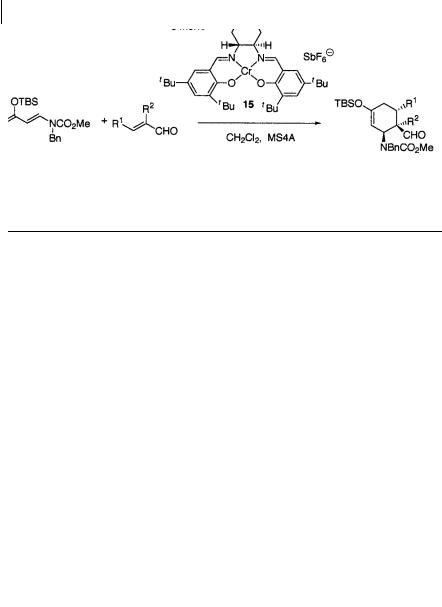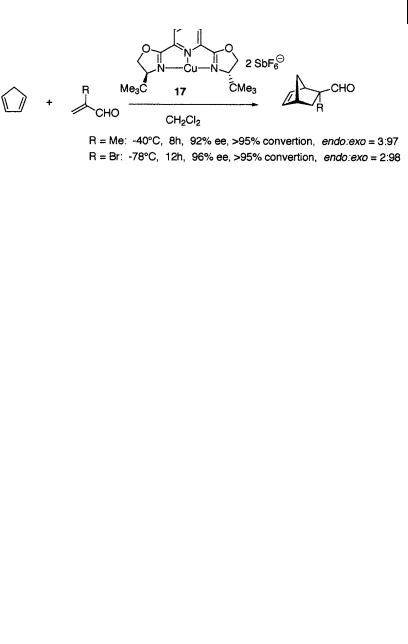
Cycloaddition Reactions in Organic Synthesis
.pdf
1.2 The Chiral Lewis Acid-catalyzed Diels-Alder Reaction 17
Scheme 1.21
Table 1.8 Asymmetric Diels-Alder reactions of alkynyl aldehydes catalyzed by 9 [12]
R |
Yield (%) |
ee (%) |
|
|
|
Me3Si |
68 |
87 |
Et3Si |
37 |
85 |
Me2PhSi |
50 |
87 |
Bu3Sn |
83 |
80 |
|
|
|
as follows: one of the N-CH2Ar substituents serves to block attack on the lower face of the s-trans-coordinated dienophile, whereas the other screens off another region in space and limits the rotation of both the dienophile and the other N-CH2Ar group. In the transition state, the formyl hydrogen atom is placed in proximity to the oxygen substituent on the boron atom, and held there by a C–H····O hydrogen bond to the equatorial oxygen lone pair (Fig. 1.3).
The formyl C–H····O hydrogen bond idea (Fig. 1.4) was first conceived for the catalyst 9 and its existence is supported by several X-ray studies of BX3·aldehyde
Fig. 1.3 Transition structure of the cationic oxazaborinane 9
Fig. 1.4 Hydrogen bond of formyl CH

18 1 Catalytic Asymmetric Diels-Alder Reactions
complexes performed by Corey and coworkers [13]. The X-ray crystal structures of the complexes C6H5CHO·BF3 [14], H2C=C(CH3)CHO·BF3 [15], and DMF·BX3 (X = F, Cl, Br, I) [13 a] reveal:
(i)BX3 is coordinated to the oxygen lone pair, which is syn to the formyl proton.
(ii)The carbonyl·BF3 complex prefers the eclipsed-coplanar B–F/formyl arrangement, but the complexes DMF·BX3 (X = Cl, Br, I) do not.
(iii)For carbonyl·BF3 complexes, the distance between the eclipsed H (formyl) and F (borane) is considerably less than the sum of the van der Waals radii.
These results suggest an attractive interaction or weak hydrogen bond between the formyl proton and eclipsed fluorine. The X-ray crystal structure of the B-bro- mocatecholborane–DMF complex also suggests the occurrence of similar weak, attractive interaction, i.e. a hydrogen bond, between the formyl group and nearby oxygen. This novel hydrogen-bonding effect between a coordinated formyl and oxygen substituents at boron can be used to rationalize several enantioselective Diels-Alder reactions of chiral Lewis catalysts such as Corey’s super-Lewis acidic catalyst 9 (vide supra), Corey’s (S)-tryptophan derived borane 4, Yamamoto’s chiral acyloxyborane (CAB) 3, Yamamoto’s Brønsted acid-assisted chiral Lewis acids (BLA) 7 and 8, Yamamoto’s chiral helical titanium catalyst (vide infra) 10, and Koga’s menthoxyaluminum chloride 1 [13 b, c].
1.2.1.3 Titanium
Yamamoto et al. have reported a chiral helical titanium catalyst, 10, prepared from a binaphthol-derived chiral tetraol and titanium tetraisopropoxide with azeotropic removal of 2-propanol [16] (Scheme 1.22, 1.23, Table 1.9). This is one of the few catalysts which promote the Diels-Alder reaction of -unsubstituted aldehydes such as acrolein with high enantioselectivity. Acrolein reacts not only with cyclopentadiene but also 1,3-cyclohexadiene and 1-methoxy-1,3-cyclohexadiene to afford cycloadducts in 96, 81, and 98% ee, respectively. Another noteworthy feature of the titanium catalyst 10 is that the enantioselectivity is not greatly influenced by reaction temperature (96% ee at
–78 C, 92% ee at –20 C, 88% ee at 0 C in the reaction of acrolein and cyclopentadiene). This is unusual for metal-catalyzed asymmetric reactions, with only few similar examples. The titanium catalyst 10 acts as a suitable chiral template for the conformational fixing of a, -unsaturated aldehydes, thereby enabling efficient enantioface recognition, irrespective of temperature.
Another chiral titanium reagent, 11, was developed by Corey et al. [17] (Scheme 1.24). The catalyst was prepared from chiral cis-N-sulfonyl-2-amino-1-indanol and titanium tetraisopropoxide with removal of 2-propanol, followed by treatment with one equivalent of SiCl4, to give the catalytically-active yellow solid. This catalyst is thought not to be a simple monomer, but rather an aggregated species, as suggested by 1H NMR study. Catalyst 11 promotes the Diels-Alder reaction of -bro- moacrolein with cyclopentadiene or isoprene.

1.2 The Chiral Lewis Acid-catalyzed Diels-Alder Reaction 19
Scheme 1.22
Scheme 1.23
Table 1.9 Asymmetric Diels-Alder reactions of cyclopentadiene catalyzed by 10 [16]
R1 |
R2 |
Temp. ( C) |
Time (h) |
Yield (%) |
endo/exo |
ee (%) |
|
H |
H |
–78 |
3.5 |
70 |
85 |
: 15 |
96 |
Me |
H |
–40 |
50 |
76 |
70 |
: 30 |
95 |
H |
Me |
–78 |
70 |
75 |
1 |
: 99 |
94(S) |
|
|
|
|
|
|
|
|
Scheme 1.24
Mikami et al. have reported that the chiral titanium reagent 12 derived from binaphthol and TiCl2(O-i-Pr)2 catalyzes the Diels-Alder reaction of -bromoacrolein or methacrolein with isoprene or 1-methoxy-1,3-butadiene to afford the cycloadducts with high enantioselectivity [18] (Scheme 1.25).

20 1 Catalytic Asymmetric Diels-Alder Reactions
Scheme 1.25
1.2.1.4 Iron
Kündig and coworkers have developed a cationic Cp iron(II) complex 13 containing the 1,2-(bis(pentafluorophenyl)phosphanyl)cyclopentane or diphenyl ethane moiety as ligand [19] (Scheme 1.26, Table 1.10). The catalyst 13 was prepared by reacting CpFeMe(CO)2 with the appropriate fluorophenyl ligand under irradiation, followed by treatment with HBF4. The Diels-Alder reaction is performed in the presence of 2,6-di-tert-butylpyridine to inhibit a competing reaction resulting from an achiral Lewis acid. Though the cationic chiral iron catalyst 13 is not thermally stable (it decomposes slowly above –20 C), in its presence -bromoacrolein reacts with both reactive and unreactive dienes such as cyclohexadiene, giving adducts in good optical purity (>95% ee).
Scheme 1.26
Table 1.10 Asymmetric Diels-Alder reactions of cyclopentadiene catalyzed by 13 [19]
R1 |
R2 |
Temp. ( C) |
Time (h) |
Yield (%) |
endo/exo |
ee (%) |
|
|
|
|
|
|
|
|
|
H |
H |
–30 |
16 |
44 |
62 |
: 38 |
87 |
H |
Me |
–20 |
20 |
83 |
2 |
: 98 |
97 |
H |
Br |
–20 |
2 |
83 |
6 |
: 94 |
95 |
|
|
|
|
|
|
|
|

1.2 The Chiral Lewis Acid-catalyzed Diels-Alder Reaction 21
1.2.1.5 Ruthenium
Kündig et al. recently applied the same perfluoroaryldiphosphonite ligand to the preparation of a cationic Ru catalyst 14 [20] (Scheme 1.27, Table 1.11). This catalyst also promotes the Diels-Alder reaction of -bromoacrolein and cyclopentadiene, although this Diels-Alder reaction is slower than that catalyzed by the analogous cationic Fe complex 13, and gives the cycloadducts with lower enantioselectivity (Fe 97% ee, Ru 92% ee).
Scheme 1.27
Table 1.11 Asymmetric Diels-Alder reactions of cyclopentadiene catalyzed by 14 [20]
R |
Time (h) |
Yield (%) |
endo/exo |
ee (%) |
|
|
|
|
|
Br |
2 |
93 |
7 : 93 |
92 |
Me |
22 |
91 |
3 : 97 |
92 |
|
|
|
|
|
1.2.1.6 Chromium
In most of the successful Diels-Alder reactions reported, dienes containing no heteroatom have been employed, and enantioselective Diels-Alder reactions of multiply heteroatom-substituted dienes, e.g. Danishefsky’s diene, are rare, despite their tremendous potential usefulness in complex molecular synthesis. Rawal and coworkers have reported that the Cr(III)-salen complex 15 is a suitable catalyst for the reaction of -substituted a, -unsubstituted aldehydes with 1-amino-3-siloxy dienes [21] (Scheme 1.28, Table 1.12). The counter-ion of the catalyst is important and good results are obtained in the reaction using the catalyst paired with the SbF–6 anion.
1.2.1.7 Copper
Kanemasa et al. discovered an asymmetric Diels-Alder reaction of acryloyl-oxazolidi- none and cyclopentadiene catalyzed by a chiral aqua complex of 4,6-dibenzofurani- dyl-2,2 -bis(4-phenyloxazoline) 16 (vide infra) [22]. Unlike the Diels-Alder reaction of acryloyloxazolidinone, for which NiBr2/AgClO4 and ZnI2/AgClO4 are the most suitable sources of the central metal, the best for the Diels-Alder reaction of -bromo-

22 1 Catalytic Asymmetric Diels-Alder Reactions
Scheme 1.28
Table 1.12 Asymmetric Diels-Alder reactions catalyzed by the Cr-salen complex 15 [21]
R1 |
R2 |
Temp. ( C) |
Time (days) |
Yield (%) |
ee (%) |
H |
Me |
–40 |
2 |
93 |
97 |
H |
i-Pr |
–40 |
5 |
92 |
>97 |
H |
TBSO |
–40 |
2 |
86 |
>97 |
|
–(CH2)3– |
–40–23 |
5 |
76 |
96 |
|
|
|
|
|
|
acrolein and cyclopentadiene is Cu(SbF6)2, the catalyst derived from which gives the cycloadduct in 86% ee (Scheme 1.29). As only one example of the Diels-Alder reaction using a, -unsaturated aldehydes has been reported, it is necessary to examine further the scope and limitations of the use of this catalyst with other aldehydes.
Scheme 1.29
Evans et al. reported that the bis(oxazolinyl)pyridine (pybox) complex of copper(II) 17 is a selective catalyst of Diels-Alder reactions between -bromoacrolein or methacrolein and cyclopentadiene affording the adducts in high enantioselectivity [23] (Scheme 1.30). Selection of the counter-ion is important to achieve a satisfactory reaction rate and enantioselectivity, and [Cu(pybox)](SbF6)2 gave the best result. This catalyst is also effective for the Diels-Alder reaction of acrylate dienophiles (vide infra).

1.2 The Chiral Lewis Acid-catalyzed Diels-Alder Reaction 23
Scheme 1.30
1.2.2
The Asymmetric Diels-Alder Reaction of -Unsaturated Esters as Dienophiles
Unlike many excellent results for the Diels-Alder reaction of a, -unsaturated aldehydes (Section 2.1), and 3-alkenoyl-1,3-oxazolidin-2-ones (Section 2.3), there are few successful Diels-Alder reactions using a, -unsaturated esters as the dienophile. Even so three outstanding asymmetric catalysts are described in this section. Hawkins et al. developed a chiral borane catalyst 18, which was prepared by hydroboration of 1-(1-naphthyl)cyclohexene with HBCl2, resolution with menthone, and then treatment with BCl3 [24]. X-ray structural analysis of the complex of the catalyst and methyl crotonate revealed not only the usual binding of the carbonyl to the Lewis acid but also additional binding – an electrostatic and dipole-in- duced dipole attraction between the boron-activated carboalkoxy group of the dienophile and the electron-rich and polarizable arene of the catalyst. In the presence of this catalyst cyclopentadiene and cyclohexadiene react with methyl acrylate, methyl crotonate, and dimethyl fumarate to afford the adducts in high optical purity (Scheme 1.31, Table 1.13).
Scheme 1.31
Wulff and coworkers have applied their aluminum catalyst 2 containing a vaulted biphenanthrol ligand (VAPOL, Section 2.1) to the Diels-Alder reaction between methyl acrylate and cyclopentadiene [25] (Scheme 1.32). In this Diels-Alder reaction auto-induction is observed, because of a cooperative interaction between the product

24 1 Catalytic Asymmetric Diels-Alder Reactions
Table 1.13 Asymmetric Diels-Alder reactions catalyzed by 18 [24]
R |
n |
Yield (%) |
ee (%) |
|
|
|
|
H |
1 |
97 |
97 |
Me |
1 |
91 |
93 |
CO2Me |
1 |
92 |
90 |
H |
2 |
83 |
86 |
|
|
|
|
with the catalyst to generate a new, more selective catalyst species. In the presence of di-tert-butyl dimethylmalonate (50 mol%), the optical purity of the product was increased from 82% ee to > 99% ee. This additive mimics the auto-inductive effect of the product but achieves greater inductions than are possible with product alone.
Scheme 1.32
Evans’s bis(oxazolinyl)pyridine (pybox) complex 17, which is effective for the Diels-Alder reaction of -bromoacrolein and methacrolein (Section 2.1), is also a suitable catalyst for the Diels-Alder reaction of acrylate dienophiles [23] (Scheme 1.33). In the presence of 5 mol% of the Cu((R)-pybox)(SbF6)2 catalyst with a benzyl substituent, tert-butyl acrylate reacts with cyclopentadiene to give the adduct in good optical purity (92% ee). Methyl acrylate and phenyl acrylate underwent cycloadditions with lower selectivities.
1.2.3
The Asymmetric Diels-Alder Reaction of 3-Alkenoyl-1,3-oxazolidin-2-ones as Dienophile
Chiral 3-alkenoyl-1,3-oxazolidin-2-ones have been developed and used in highly diastereoselective Diels-Alder reactions by Evans et al. [26] (Scheme 1.34). In this reaction these dienophiles are highly reactive compared with the corresponding

1.2 The Chiral Lewis Acid-catalyzed Diels-Alder Reaction 25
Scheme 1.33
ester. Lewis acids such as Et2AlCl coordinate to the dienophile in a two-point binding fashion (Fig. 1.5). After Evans’s investigations of the diastereoselective reactions of chiral 3-alkenoyl-1,3-oxazolidin-2-ones, many chiral Lewis acids have been developed and applied to the Diels-Alder reaction of their achiral 3-alkenoyl- 1,3-oxazolidin-2-one counterparts.
Scheme 1.34
The first successful application of a chiral Lewis acid to the Diels-Alder reaction of these 3-alkenoyl-1,3-oxazolidin-2-ones was Narasaka’s TADDOL-based, chiral titanium catalyst in 1986 (vide infra) [27]. A catalytic amount of this chiral titanium reagent can promote the Diels-Alder reaction highly efficiently to give the cycloadduct in over 90% ee. Since Narasaka’s work the Diels-Alder reaction of 3-alkenoyl- 1,3-oxazolidin-2-ones has come to be regarded as a test case for newly-developed chiral Lewis acids having two-point binding ability, because the cycloadducts obtained are synthetically useful chiral building blocks. Complexes derived from many kinds of metal, including Al(III), Mg(II), Cu(II), Fe(III), Ni(II), Ti(IV), Zr(IV), and Yb(III) with chiral ligands have been devised. In this section the catalysts are classified according to their central metal.
Fig. 1.5 Coordination of Et2AlCl with chiral crotonoyl-1,3- oxazolidin-2-one derivative

26 1 Catalytic Asymmetric Diels-Alder Reactions
1.2.3.1 Aluminum
Corey et al. reported that the catalyst 19, prepared from trimethylaluminum and the bis-trifluorosulfonamide of stilbenediamine (stien), with generation of methane, is a suitable catalyst for the Diels-Alder reaction of 3-acryloyl, and 3-crotonoyl-1,3-oxazo- lidin-2-ones, giving the cycloadducts in high optical purity [28] (Scheme 1.35, Table 1.14). X-ray structure analysis of the catalyst and 1H and 13C NMR studies revealed that 3-alkenoyl-1,3-oxazolidin-2-one binds with the chiral Lewis acid at a single point, though the dienophile is thought to be a good two-point binding ligand [29]. The dienophile is, moreover, thought to adopt an s-trans conformation in the transition state, while the reaction proceeds through the s-cis conformation for other chiral Lewis acids. This catalyst has also been applied to the Diels-Alder reaction of 5-(benzoxy- methyl)-1,3-cyclopentadiene in the synthesis of a key intermediate for prostaglandins.
Scheme 1.35
Table 1.14 Asymmetric Diels-Alder reactions catalyzed by 19 [28]
R |
Yield (%) |
endo/exo |
ee (%) |
|
|
|
|
H |
92 |
>50 : 1 |
91 |
Me |
88 |
96 : 4 |
94 |
|
|
|
|
1.2.3.2 Magnesium
Several chiral magnesium catalysts have been reported. Corey et al. found that bis(oxazoline)magnesium catalyst 20 promotes the Diels-Alder reaction of acryloyl oxazolidinone and cyclopentadiene to give adducts in 91% ee [30]. The catalyst 20 was prepared from bis(oxazoline) and magnesium iodide in the presence of I2 to remove iodide. Other bis(oxazoline)-magnesium catalysts have been intensively investigated by Desimoni et al. [31], who prepared them from three different bis(oxazolines) and magnesium perchlorate or triflate. Although the catalyst 21, with the perchlorate anion, gave the 2S adduct in moderate optical purity (72% ee) on reaction of acryloyl derivative and cyclopentadiene, the opposite enantiomer (2R, 70% ee) was obtained by adding 2 equiv. water under the same reaction conditions. This is one of the few examples where the absolute stereochemistry of the product is reversed by an achiral additive. The best optical purity was realized by the catalyst 22 containing the triflate anion, which gave the cycloadduct in 93%
